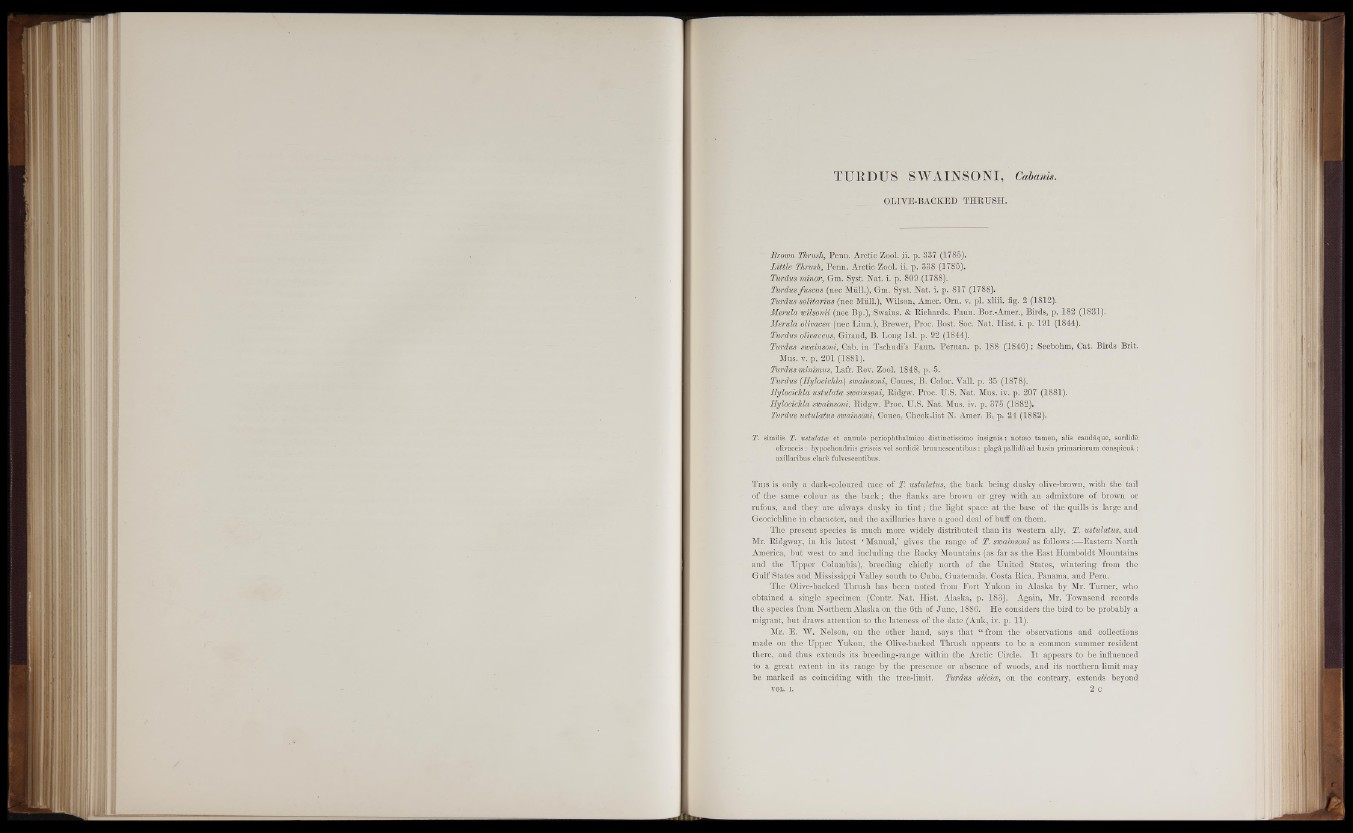
HI
TURDUS SWAINSONI, Cabanis.
OLIVE-BACKED THRUSH.
Brown Thrush, Penn. Arctic Zool. ii. p. 337 (1785).*
Little Thrush1 Penn. Arctic Zool. ii. p. 338 (1785).
Turdus minor, Gm. Syst. Nat. i. p. 809 (1788).
Turdus fuscus (nec Müll.), Gm. Syst. Nat. i. p. 817 (1788).
Turdus solitarius (nec Müll.), Wilson, Amer. Orn. v. pi. xliii. fig. 2 (1812).
Merula wilsonii (nec Bp.), Swains. & Richards. Faun. Bor.-Amer., Birds, p. 182 (1831).
Merula olivacea (nec Linn.), Brewer, Proc. Bost. Soc. Nat. Hist. i. p. 191 (1844).
Turdus olivaceus, Giraud, B. Long Isl. p. 92 (1844).
Turdus swainsoni, Cab. in Tschudi’s Faun. Peruan. p. 188 (1846); Seebohm, Cat. Birds Brit.
Mus. v. p. 201 (1881).
Turdus minimus, Lair. Rev. Zool. 1848, p. 5.
Turdus (Hylocichla) swainsoni, Coues, B. Color. Vail. p. 35 (1878).
Hylocichla ustulata swamsoni, Ridgw. Proc. U.S. Nat. Mus. iv. p. 207 (1881).
Hylocichla swainsoni, Ridgw. Proc. U.S. Nat. Mus. iv. p. 375 (1882).
Turdus ustulatus swainsoni, Coues, Check-list N. Amer. B. p. 24 (1882).
T. similis T. ustulatce et annulo periophthalmico distinctissimo insignis: notseo tarnen, alis eaudaque, sordide
' olivaceis: hypochondriis griseis vel sordide brunnescentibus : plagä pallida ad basin primariorum conspicuS.:
axillaribus clare fulvescentibus.
T his is only a dark-coloured race of T. ustulatus, the back being dusky olive-brown, with the tail
of the same colour as the back; the flanks are brown or grey with an admixture of brown or
rufous, and they are always dusky in tin t; the light space at the base of the quills is large and
Geocichline in character, and the axillaries have a good deal of buff on them.
The present species is , much more widely distributed than its western ally, T. ustulatus, and
Mr. Ridgway, in his latest * Manual,’ gives the range of T. swainsoni as follows :—Eastern North
America, but west to and including the Rocky Mountains (as far as the East Humboldt Mountains
and the Upper Columbia), breeding chiefly north of the United States, wintering from the
Gulf States and Mississippi Valley south to Cuba, Guatemala, Costa Rica, Panama, and Peru.
The Olive-backed Thrush has been noted from Fort Yukon in Alaska by Mr. Turner, who
obtained a single specimen (Contr. Nat. Hist. Alaska, p. 183). Again, Mr. Townsend records
the species from Northern Alaska on the 6th of June, 1886. He considers the bird to be probably a
migrant, but draws attention to the lateness of the date (Auk, iv. p. 11).
Mr. E. W. Nelson, on the other hand, says that “ from the observations and collections
made on the Upper Yukon, the Olive-backed Thrush appears to be a common summer resident
there, and thus extends its breeding-range within the Arctic Circle. It appears to be influenced
to a great extent in its range by the presence or absence of woods, and its northern limit may
be marked as coinciding with the tree-limit. Turdus alicice, on the contrary, extends beyond
vol. i. 2 c